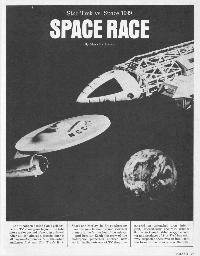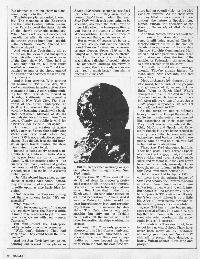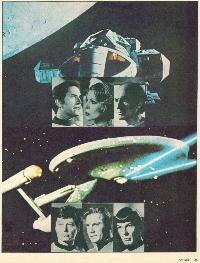Educational Press
Space Race
Smash Volume 2 Number 6, 1975, page 27-29
Smash magazine was a 1975 US teenage music magazine published by Xerox Education Publications and distributed through school book clubs.
by Mark Saltzman
Can it happen again? Can a science-fiction TV show grow beyond the tube into a major current of popular culture? After all, it's almost a decade since it all began - September 8, 1966 - when audiences first saw Star Trek's Kirk, Spock and McCoy "boldly go where no man has gone before," to undiscovered planets in the far reaches of the galaxy,
And here on Earth the crew of the Enterprise pioneered another new world. In the universe of TV they discovered an untouched area- intelligent, scientifically accurate, science fiction. As Gene Roddenberry, the creator and producer of Star Trek has said, "We suspected there was an intelligent life form on the other side of the tube. We planned to use our show to signal some thoughts to them."
The tube-people responded. Incredibly. The members of the Enterprise and their 23rd Century culture became alive. Fans followed the tiniest details of the show's futuristic technology. When Star Trek seemed doomed for cancellation after its second season, the protest was so huge that - get this - the network actually listened and the show stayed on the air!
And when Star Trek finally did go off the air, the viewers did not quietly turn their attention to the new episodes of the Lucy show. No! They held on "not only held on, but their ranks swelled as more and more "Trekkies" watched re-runs of the show, entered the culture and absorbed the 23rd Century life-style.
And it kept growing. With nothing but re-runs on TV in the 70s, Star Trek conventions in various cities drew thousands of fans. A store selling nothing but Star Trek items thrived in Berkeley, California then opened a branch in New York City. The blue prints of the U.S.S. Enterprise, at $5.00 a kit, startled the publishing world by becoming a nationwide book store best-seller. Millions of dollars are budgeted for a full-length Star Trek movie. Clearly the public is wild for Star Trek! For TV sci-fi! For space!
So thought the creators of Space 1999. a new sci-fi show that boldly goes where Star Trek went before. No, Space 1999 is not a galactic phone exchange. But though it is the old interstellar space travel number, the show tries giving it a new twist.
Instead of being safely aboard a futuristic Nina, Pints and Santa Maria, the Space folks are on a runaway planet. Well, not exactly a planet - it's our very own moon, ladies and gentlemen, torn out of its orbit and bouncing through space like the ball in a cosmic pinball game.
The folks aboard have given up any chance of getting back home. Instead, they are in search of a pleasant planet to settle upon. A nice basic idea for a plot.
"No!" scream the Trekkies pulling out their astronomy books, It's un-scientific!"
Why? Where?
"Well, for openers, even if the moon did somehow leave the Earth's orbit, it would take centuries to get into another solar system with new planets. Centuries!"
But wait - didn't the Enterprise boldly go into other solar systems?
"Well, that's different. They had warp-drive. They could break the time barrier."
And the Star Trek loyalists go on, pointing out several other places in Space 1999 where science is sacrificed for fiction, But if they were totally honest, they"d have to admit that even Star Trek, which took such pains to be scientific, stretched the facts now and then. Like when the Enterprise flies by you during the opening of the show. Whoooooshhhh. But that's the vacuum of space out there, no air, no sound.
But so what. Of course, it's better to have real science, but even the hardest- nosed Trekkie forgives an occasional science blooper. Space 1999 can't be hanged on a charge of science-stretching. And the show also includes a razzle-dazzle display of special effects. The planetary landings, the views of deep space, the low gravity scenes are, well, really much better than similar effects on Star Trek,
But it isn't science accuracy or special effects that brought about Star Trek mania.
By the time Star Trek went off the air, it had given its viewers a pretty good sense of life in the 23rd Century. Besides all the new technology that was shown, they knew that in the future Earth would join with other planets in a United Federation of Planets. And it was the Federation which would impose interplanetary laws and organize exploration of the universe by star ships. The Enterprise is one such starship - but only one. A Trekkie could rattle off the names of the 13 other Federation starships cruising the Cosmos.
Although Star Trek only gave us a glimpse of this 23rd Century universe, the fragments were convincing. We knew all the time there was a huge reality out there, beyond the Enter prise. From the start, the Star Trek creators had an overall vision of the 23rd Century universe. As the show went on, they filled in more pieces of information -the nature of Spock's home planet, Vulcan, the operation of the starship, the society of 23rd Century Earth.
And now, though Star Trek is off the air, more information about its universe is still being revealed. The Enterprise blueprints fill in the smallest details of every corner of the starship. The new Starship Commander's Manual is filled with previously unreleased information, including the text of the Articles of Federation, the space-laws so often referred to in the show.
And still, the Trekkies can never get enough. They"re always hungry for more, more, Star Trek info, and that keeps the cult thriving.
Now, on Space 1999, there's a futuristic world, but outside of the geegaws and gimcracks of it, we really know little. What is Earth like? What's changed in the culture? And in a mere 23 years, how much change could there be? After all, every one of those Space 1999 people supposedly walked (or toddled) on Earth in 1976.
So the '99ers are not so different from you and me. Except they're duller. So far the characters have seemed like extensions of their machinery. They don't arouse the interest that Kirk, McCoy, and Spock did. Especially Spock! His very being seemed to sum up the conflict between man and technology. And besides, he had those pointy ears, he was an alien, you had to find out more about him.
Those Star Trek characters had life. They had pasts. They (except Spock of course) got angry, tired, confused, love-stricken and (even Spock!) made jokes and wisecracks. Star Trek never took itself absolutely seriously. Some how, the ability to laugh at itself made Star Trek even more believable.
But all is not lost for Space 1999. It will never have the cultural impact of Star Trek because the universe it shows is not so different from our own; there isn't a totally new world to climb into. But there's still no reason why it can't be a top-notch TV sci-fi show. If only the '99ers would lighten it up a little bit. After all, even people stranded in lifeboats sing songs once in a while,
Space 1999 has a huge budget and extra-special effects. If it would be put together with some better scripts and some character overhauls, the show could be a solid success.
And sci-fi fans, Trekkies or not, have to root for a new sci-fi show. There have never been many on TV, certainly not many good ones, and Space 1999 with all its present flaws deserves a hearty Vulcan salute: "Live long and prosper."
Photos:



Space: 1999 copyright ITV Studios Global Entertainment